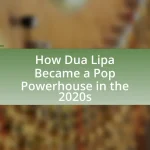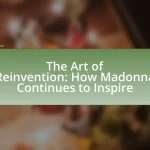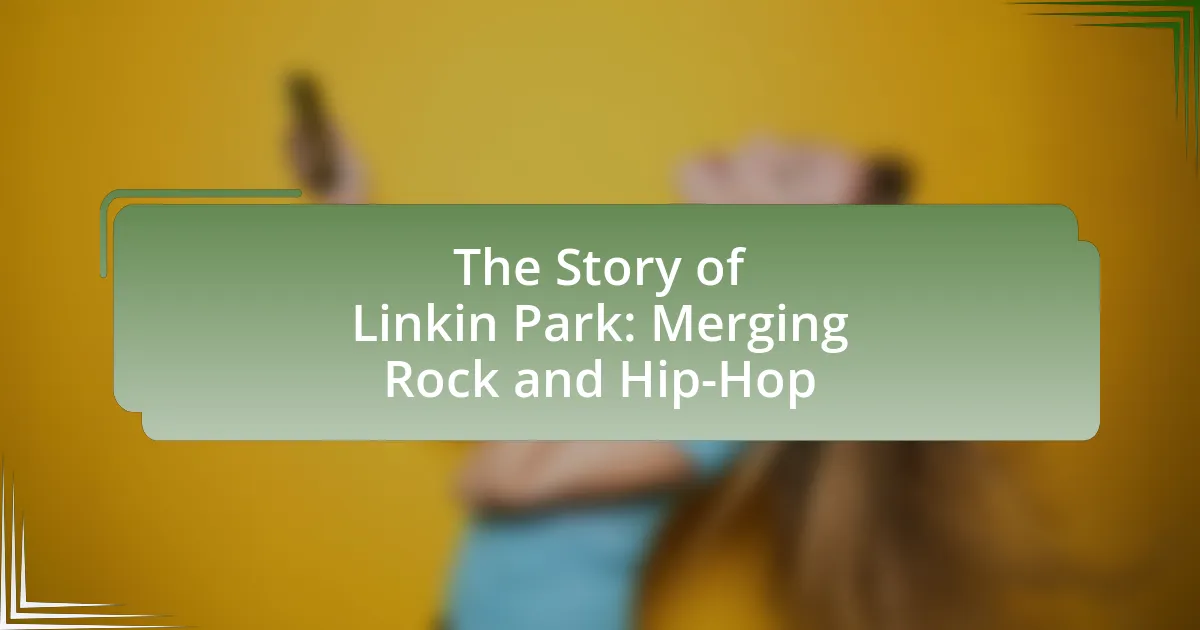Hozier, an Irish musician, gained international fame with his breakout single “Take Me to Church” in 2013, which addressed themes of love, sexuality, and social issues. His self-titled debut album, released in 2014, solidified his place in the music industry, followed by his successful sophomore album “Wasteland, Baby!” in 2019, which debuted at number one on the Billboard 200 chart. The article explores Hozier’s musical journey, including the critical and commercial responses to his work, the themes present in his music, his collaborations, and his activism. It also discusses his evolving artistic direction and future projects, highlighting his commitment to meaningful content and social issues.

What is the Journey of Hozier?
Hozier’s journey began with the release of his breakout single “Take Me to Church” in 2013, which garnered international acclaim and highlighted his soulful voice and poignant lyrics. Following this success, Hozier released his self-titled debut album in 2014, which included other notable tracks and solidified his place in the music industry. His music often explores themes of love, spirituality, and social issues, resonating with a wide audience. In 2019, he released his sophomore album, “Wasteland, Baby!”, which debuted at number one on the Billboard 200 chart, showcasing his growth as an artist. Hozier’s journey reflects a continuous evolution in his music and artistry, marked by a commitment to authenticity and emotional depth.
How did Hozier rise to fame with ‘Take Me to Church’?
Hozier rose to fame with “Take Me to Church” by releasing a powerful song that resonated with listeners worldwide, addressing themes of love, sexuality, and social issues. The track, released in 2013, quickly gained traction on platforms like YouTube, where its music video garnered millions of views, amplifying its reach. Additionally, “Take Me to Church” topped charts in multiple countries, including the US and UK, and received critical acclaim, earning a Grammy nomination for Song of the Year in 2015. This combination of emotional depth, widespread media exposure, and commercial success solidified Hozier’s status as a prominent artist in the music industry.
What themes are explored in ‘Take Me to Church’?
The themes explored in “Take Me to Church” include love, sexuality, and the critique of organized religion. The song addresses the struggles of being in a same-sex relationship and the societal pressures that accompany it, highlighting the conflict between personal identity and religious dogma. Hozier uses vivid imagery to illustrate the pain and hypocrisy often found in religious institutions, emphasizing the importance of love and acceptance over judgment. This thematic exploration resonates with listeners, as it challenges conventional beliefs and advocates for individual freedom and authenticity.
How did the music video contribute to the song’s impact?
The music video for “Take Me to Church” significantly enhanced the song’s impact by visually representing its themes of love, struggle, and societal issues. The imagery of the video, which includes powerful scenes depicting the discrimination faced by the LGBTQ+ community, resonated with viewers and sparked conversations about these critical social topics. This alignment between the visuals and the song’s message contributed to its viral success, leading to over 1 billion views on platforms like YouTube, thereby amplifying its reach and emotional resonance. The combination of evocative storytelling and poignant visuals solidified the song’s status as an anthem for social justice, further embedding it in cultural discussions.
What were the critical and commercial responses to Hozier’s debut?
Hozier’s debut album received widespread critical acclaim and commercial success. Critics praised the album for its soulful sound, lyrical depth, and blending of genres, with particular emphasis on the hit single “Take Me to Church,” which garnered a Grammy nomination for Song of the Year. Commercially, the album debuted at number two on the Billboard 200 chart and was certified multi-platinum in several countries, including the United States and Canada, indicating strong sales and popularity.
How did ‘Take Me to Church’ perform on music charts?
“Take Me to Church” by Hozier achieved significant success on music charts worldwide. The song peaked at number two on the Billboard Hot 100 in the United States and reached number one in several countries, including Ireland and the United Kingdom. Its commercial performance was bolstered by its critical acclaim, leading to over 1.5 million copies sold in the U.S. alone and multiple platinum certifications in various regions.
What awards and nominations did Hozier receive for his debut work?
Hozier received several awards and nominations for his debut work, particularly for his hit single “Take Me to Church.” He was nominated for a Grammy Award for Song of the Year in 2015. Additionally, he won the 2015 Billboard Music Award for Top Streaming Song (Video) and received nominations for the MTV Video Music Awards and the iHeartRadio Music Awards. These accolades highlight the significant impact of his debut work on the music industry.
What influences shaped Hozier’s musical style?
Hozier’s musical style is shaped by a blend of folk, blues, and soul influences. His Irish heritage plays a significant role, as traditional Irish music and literature inform his songwriting and thematic choices. Additionally, Hozier cites artists like Bob Dylan and Nina Simone as key inspirations, reflecting a deep appreciation for lyrical storytelling and emotional depth. The fusion of these elements creates a distinctive sound that resonates with listeners, evident in his breakout hit “Take Me to Church,” which combines soulful melodies with poignant social commentary.
How do Hozier’s Irish roots influence his music?
Hozier’s Irish roots significantly influence his music by infusing it with elements of traditional Irish folk, storytelling, and cultural themes. His upbringing in County Wicklow and exposure to Irish literature and music shape his lyrical content, often reflecting themes of love, spirituality, and social issues, which resonate with the Irish experience. For instance, his song “Take Me to Church” critiques institutional power, echoing historical struggles in Ireland, while his use of traditional Irish instruments and melodies in tracks like “Almost (Sweet Music)” showcases his cultural heritage. This blend of contemporary and traditional influences creates a unique sound that is distinctly reflective of his Irish identity.
What artists and genres have inspired Hozier’s sound?
Hozier’s sound has been inspired by a blend of artists and genres, notably blues, soul, and folk music. Influential figures include artists like Bob Dylan, Van Morrison, and Nina Simone, whose emotive storytelling and vocal styles resonate in Hozier’s work. The incorporation of gospel elements and the rhythmic structures of blues further shape his musical identity, evident in tracks like “Take Me to Church,” which showcases a fusion of these influences.
What are the key milestones in Hozier’s career after ‘Take Me to Church’?
After “Take Me to Church,” Hozier achieved several key milestones, including the release of his self-titled debut album in 2014, which debuted at number two on the Billboard 200 and was certified multi-platinum. In 2019, he released his sophomore album, “Wasteland, Baby!”, which debuted at number one on the Billboard 200, making him the first Irish act to top the chart since 2011. Additionally, Hozier’s single “Movement” from this album received critical acclaim and significant radio play. He also gained recognition for his live performances, including a notable appearance at the 2020 Coachella Festival. These milestones reflect Hozier’s continued success and evolution as an artist following his breakout hit.
How did Hozier’s sophomore album differ from his debut?
Hozier’s sophomore album, “Wasteland, Baby!”, differs from his debut album, “Hozier”, primarily in its thematic depth and musical experimentation. While the debut featured a strong focus on love and spirituality, the sophomore album expands to explore broader societal issues, including climate change and personal struggles, reflecting a more mature perspective. Additionally, “Wasteland, Baby!” incorporates a wider variety of musical styles, blending elements of rock, folk, and R&B, which showcases Hozier’s growth as an artist. This evolution is evident in tracks like “Movement” and “Almost (Sweet Music)”, which highlight his innovative approach to songwriting and sound.
What themes are prevalent in Hozier’s second album?
Hozier’s second album, “Wasteland, Baby!”, prominently features themes of love, spirituality, and social justice. The exploration of love is multifaceted, encompassing romantic relationships and self-love, while spirituality is woven throughout the lyrics, reflecting a connection to the divine and nature. Additionally, social justice themes address issues such as inequality and the human condition, evident in tracks that critique societal norms and advocate for change. These themes are reinforced by Hozier’s lyrical depth and musical style, which combine to create a rich narrative throughout the album.
How did the reception of the second album compare to the first?
The reception of Hozier’s second album, “Wasteland, Baby!”, was more favorable than that of his first album, “Hozier”. “Wasteland, Baby!” debuted at number one on the Billboard 200 chart, marking a significant achievement compared to the first album, which peaked at number two. Critics praised the sophomore effort for its lyrical depth and musical evolution, with a Metacritic score of 84, indicating generally favorable reviews, whereas the first album had a score of 76. This indicates a stronger critical and commercial reception for the second album.
What collaborations has Hozier engaged in since his debut?
Hozier has engaged in several notable collaborations since his debut. He collaborated with artist Mavis Staples on the song “Take Me to Church” for a live performance, showcasing a blend of their distinct musical styles. Additionally, Hozier worked with the band Bastille on a remix of “Take Me to Church,” further expanding his reach in the music industry. He also collaborated with the artist Maren Morris on the track “The Bones,” which highlights his versatility across genres. These collaborations illustrate Hozier’s ability to connect with diverse artists and audiences.
How have these collaborations influenced his musical direction?
Collaborations have significantly influenced Hozier’s musical direction by introducing diverse genres and innovative sounds into his work. For instance, his partnership with artists like Mavis Staples on “Nina Cried Power” infused elements of gospel and soul, enriching his folk and rock roots. This collaboration not only showcased Hozier’s versatility but also deepened his lyrical themes, reflecting social and political issues. Additionally, working with producers such as Rob Ellis has allowed him to experiment with different production techniques, resulting in a more layered and textured sound in his albums. These collaborations have collectively expanded Hozier’s artistic range and helped him evolve from the success of “Take Me to Church” to a more nuanced and multifaceted musical identity.
What notable performances has Hozier participated in post-debut?
Hozier has participated in several notable performances post-debut, including his appearances at major music festivals such as Coachella in 2019 and Glastonbury in 2022. At Coachella, he performed songs from his album “Wasteland, Baby!” which debuted at number one on the Billboard 200 chart. His Glastonbury set was particularly acclaimed, showcasing his powerful vocals and stage presence, further solidifying his status as a prominent artist in the music industry.
What social and political issues has Hozier addressed in his music?
Hozier has addressed various social and political issues in his music, including LGBTQ+ rights, religious criticism, and environmental concerns. His song “Take Me to Church” critiques the oppressive nature of organized religion, particularly regarding its stance on homosexuality, highlighting the struggles faced by the LGBTQ+ community. Additionally, Hozier’s lyrics often reflect on themes of love, social justice, and the impact of climate change, as seen in songs like “Earth” and “Nina Cried Power,” which pay homage to civil rights movements and advocate for activism. These themes demonstrate Hozier’s commitment to addressing significant societal challenges through his art.
How does Hozier use his platform to advocate for change?
Hozier uses his platform to advocate for change by addressing social issues through his music and public statements. He highlights topics such as LGBTQ+ rights, climate change, and systemic inequality, often incorporating these themes into his lyrics and performances. For instance, his song “Take Me to Church” critiques homophobia and religious hypocrisy, resonating with audiences and sparking conversations about these critical issues. Additionally, Hozier actively participates in campaigns and collaborates with organizations that promote social justice, further amplifying his message and encouraging his fans to engage in activism.
What impact has Hozier’s activism had on his fanbase?
Hozier’s activism has significantly strengthened his fanbase by fostering a deeper emotional connection and shared values among his supporters. His advocacy for social issues, particularly LGBTQ+ rights and environmental concerns, resonates with fans who appreciate his commitment to these causes. For instance, his song “Take Me to Church” became an anthem for LGBTQ+ rights, leading to increased visibility and support from communities that align with his activism. This alignment has cultivated a loyal fanbase that not only appreciates his music but also engages with the social issues he champions, thereby enhancing their overall connection to him as an artist.
What are the future directions for Hozier’s music and career?
Hozier’s future directions in music and career include exploring diverse musical styles and themes, as evidenced by his recent album “Wasteland, Baby!” which showcases a blend of folk, blues, and rock influences. He is likely to continue collaborating with various artists and producers to expand his sound, as he has previously worked with notable figures like Mavis Staples and producer Rob Ellis. Additionally, Hozier’s commitment to social issues and personal storytelling in his lyrics suggests that he will maintain a focus on meaningful content, resonating with his audience while addressing contemporary themes. His growing international presence and participation in major music festivals indicate a trajectory towards broader recognition and influence in the music industry.
What can fans expect from Hozier’s upcoming projects?
Fans can expect Hozier’s upcoming projects to feature a blend of his signature soulful sound and new musical explorations. His recent singles, including “Eat Your Young,” showcase a continued evolution in his songwriting and thematic depth, reflecting personal and societal issues. Additionally, Hozier has hinted at a forthcoming album, which is anticipated to expand on the themes of love, identity, and social commentary that have characterized his previous work. This progression is supported by his growing fanbase and critical acclaim, indicating a strong reception for his future releases.
How is Hozier evolving as an artist in his new work?
Hozier is evolving as an artist in his new work by incorporating a broader range of musical influences and themes that reflect personal and societal changes. His latest album showcases a fusion of genres, including elements of folk, rock, and blues, which demonstrates his willingness to experiment beyond the sound that defined his debut. Additionally, Hozier’s lyrics have become more introspective and socially conscious, addressing issues such as love, identity, and the human experience, which indicates a maturation in his songwriting. This evolution is evident in tracks that explore complex emotions and narratives, moving away from the singular focus of “Take Me to Church” to a more nuanced exploration of various topics.
What themes might Hozier explore in future albums?
Hozier might explore themes of love, spirituality, and social justice in future albums. His previous work, particularly in songs like “Take Me to Church,” reflects a deep engagement with the complexities of human relationships and critiques of societal norms. Additionally, Hozier has shown an interest in environmental issues and personal identity, suggesting that future projects could further delve into these areas, as evidenced by his advocacy for climate action and LGBTQ+ rights.
How does Hozier plan to engage with his audience moving forward?
Hozier plans to engage with his audience moving forward by incorporating more personal storytelling and interactive elements into his performances and social media presence. He aims to deepen the connection with fans through intimate live shows and by sharing behind-the-scenes content that reflects his artistic journey. This approach is supported by his previous success in creating emotional resonance with listeners, as seen in his hit “Take Me to Church,” which garnered widespread acclaim for its relatable themes.
What role does social media play in Hozier’s connection with fans?
Social media serves as a vital platform for Hozier to engage and connect with his fans. Through channels like Twitter, Instagram, and Facebook, Hozier shares personal insights, updates on his music, and interacts directly with his audience, fostering a sense of community. This direct communication allows fans to feel more personally connected to him, enhancing their loyalty and support. For instance, Hozier often responds to fan messages and shares user-generated content, which reinforces the bond between him and his followers.
How might Hozier’s live performances change in the future?
Hozier’s live performances may evolve to incorporate more multimedia elements and interactive experiences for the audience. As artists increasingly utilize technology to enhance live shows, Hozier could integrate visual storytelling, augmented reality, or immersive stage designs that complement his music. This shift aligns with trends observed in the music industry, where artists like Billie Eilish and Travis Scott have successfully transformed their performances into multi-sensory experiences, engaging fans on deeper levels. Such changes would not only elevate the concert experience but also reflect Hozier’s artistic growth and adaptability in a rapidly changing entertainment landscape.
What are some best practices for following Hozier’s journey?
To effectively follow Hozier’s journey, engage with his music through streaming platforms, social media, and live performances. Streaming platforms like Spotify and Apple Music provide access to his discography, including new releases and collaborations, while social media accounts such as Instagram and Twitter offer updates on his personal insights and upcoming projects. Attending live performances allows fans to experience his artistry firsthand, fostering a deeper connection to his work. Additionally, following music news outlets and fan communities can provide context and discussions around his evolving themes and influences, enhancing the overall understanding of his artistic journey.



